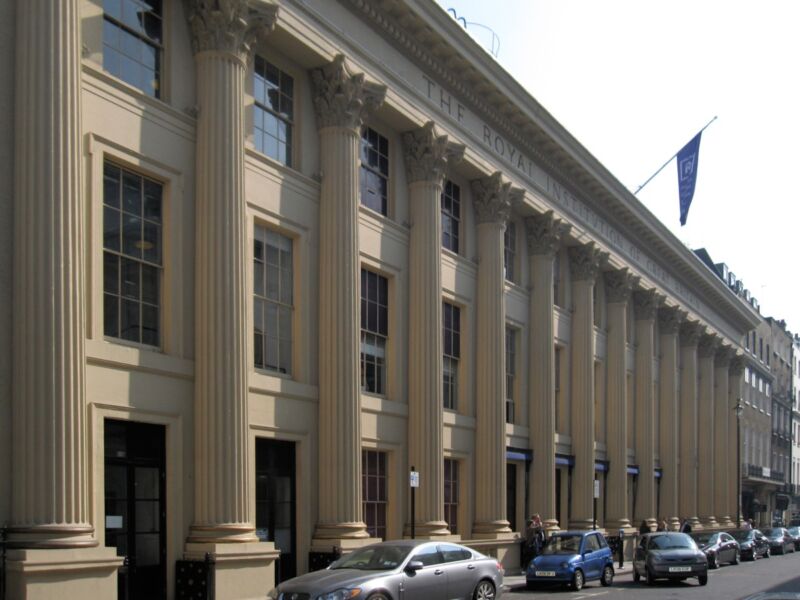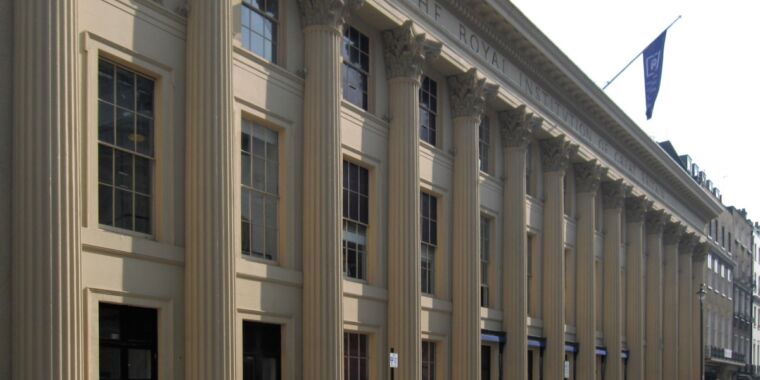Science lives here: take a virtual tour of the Royal Institution in London
a special kind of place —
No less than 14 Nobel laureates have conducted ground-breaking research at the Institution.

Enlarge / The Royal Institution was founded in 1799 and is still located in the same historic building at 21 Albermarle Street in London.
If you’re a fan of science, and especially science history, no trip to London is complete without visiting the Royal Institution, browsing the extensive collection of artifacts housed in the Faraday Museum and perhaps taking in an evening lecture by one of the many esteemed scientists routinely featured—including the hugely popular annual Christmas lectures. (The lecture theater may have been overhauled to meet the needs of the 21st century but walking inside still feels a bit like stepping back through time.) So what better time than the Christmas season to offer a virtual tour of some of the highlights contained within the historic walls of 21 Albemarle Street?
The Royal Institution was founded in 1799 by a group of leading British scientists. This is where Thomas Young explored the wave theory of light (at a time when the question of whether light was a particle or wave was hotly debated); John Tyndall conducted experiments in radiant heat; Lord Rayleigh discovered argon; James Dewar liquified hydrogen and invented the forerunner of the thermos; and father-and-son duo William Henry and William Lawrence Bragg invented x-ray crystallography.
No less than 14 Nobel laureates have conducted ground-breaking research at the Institution over the ensuing centuries, but the 19th century physicist Michael Faraday is a major focus. In fact, there is a full-sized replica of Faraday’s magnetic laboratory—where he made so many of his seminal discoveries—in the original basement room where he worked, complete with an old dumbwaiter from when the room was used as a servant’s hall. Its arrangement is based on an 1850s painting by one of Faraday’s friends and the room is filled with objects used by Faraday over the course of his scientific career.
The son of an English blacksmith, Faraday was apprenticed to a bookbinder at 14, a choice of profession that enabled him to read voraciously, particularly about the natural sciences. In 1813, a friend gave Faraday a ticket to hear the eminent scientist Humphry Davy lecture on electrochemistry at the Royal Institution. He was so taken by the presentation that he asked Davy to hire him. Davy initially declined, but shortly afterwards sacked his assistant for brawling, and hired Faraday to replace him. Faraday helped discover two new compounds of chlorine and carbon in those early days, learned how to make his own glass, and also invented an early version of the Bunsen burner, among other accomplishments.
-
Painting of the Royal Institution circa 1838, by Thomas Hosmer Shepherd.
Public domain
-
Michael Faraday giving one of his famous Christmas lectures.
Royal Institution
-
A Friday Evening Discourse at the Royal Institution; Sir James Dewar on Liquid Hydrogen, by Henry Jamyn Brooks, 1904
Public domain
-
The Lecture Theatre as it looks today
-
Faraday’s magnetic laboratory in the basement of the Royal Institution
Royal Institution
-
A page from one of Faraday’s notebooks
Royal Institution
Faraday was particularly interested in the new science of electromagnetism, first discovered in 1820 by Hans Christian Ørsted. In 1821, Faraday discovered electromagnetic rotation—which converts electricity into mechanical motion via a magnet—and used that underlying principle to build the first electric motor. The Royal Institution’s collection includes the only surviving electric motor that Faraday built: a wire hanging down into a glass vessel with a bar magnet at the bottom. Faraday would fill the glass with mercury (an excellent conductor), then connect his apparatus to a battery, which sent electricity through the wire in turn. This created a magnetic field around the wire, and that field’s interaction with the magnet at the bottom of the glass vessel would cause the wire to rotate in a clockwise direction.
Ten years later, Faraday succeeded in showing that a jiggling magnet could induce an electrical current in a wire. Known as the principle of the dynamo, or electromagnetic induction, it became the basis of electric generators, which convert the energy of a changing magnetic field into an electrical current. One of Faraday’s induction rings is on display, comprised of coils of wire wound on opposites sides of the ring, insulated with cotton. Passing electricity through one would briefly induce a current in the other. Also on display is one of Faraday’s generators: a bar magnet and a simple cotton-insulated tube wound with a coil of wire.
In yet another experiment, Faraday placed a piece of heavy leaded glass on a magnet’s poles to see how light would be affected by a magnet. He passed light through the glass and when he turned on the electromagnet, he found that the polarization of the light had rotated slightly. This is called the magneto-optical effect (or Faraday effect), demonstrating that magnetism is related not just to electricity, but also to light. The Royal Institution has a Faraday magneto-optical apparatus with which he “at last succeeded in… magnetizing a ray of light.” In 1845, Faraday discovered diamagnetism, a property of certain materials that give them a weak repulsion from a magnetic field.
-
Equipment used by Faraday to make glass
-
Drawing of Faraday’s electromagnetic rotation experiment.
Public domain
-
Faraday motor (electric magnetic rotation apparatus), 1822
Royal Institution
-
Faraday’s dynamo (generator), October 1831
Royal Institution
-
Faraday’s induction ring
Royal Institution
-
Faraday’s magneto-optical apparatus
Royal Institution
-
One of Faraday’s iron filings (1851) showing magnetic lines of force
Royal Institution
-
Faraday’s original gold colloids are still active well over a century later
-
Shining a laser light through a gold colloid mixture produces the Faraday-Tyndall Effect.
Royal Institution
Faraday concluded from all those experiments that magnetism was the center of an elaborate system of invisible curved tentacles (electric lines of force) that spread throughout space like the roots of trees branching through the earth. He was able to demonstrate these lines of force by coating sheets of paper with wax and placing them on top of bar magnets. When he sprinkled powdery iron filings on the surface, those iron filings were attracted to the magnets, revealing the lines of force. And by gently heating the waxed paper, he found that the iron filings would set on the page, preserving them.
In the 1850s, Faraday’s interests turned to the properties of light and matter. He made his own gold slides and shone light through them to observe the interactions. But commercial gold leaf, typically made by hammering the metal into thin sheets, was still much too thick for his purposes. So Faraday had to make his own via chemical means, which involved washing gold films. The resulting faint red fluid intrigued Faraday and he kept samples in bottles, shining light though the fluids and noting an intriguing “cone effect” (now known as the Faraday-Tyndall Effect)—the result of particles of gold suspended in the fluid that were much too small to see.
One might consider Faraday an early nanoscientist, since these are now known as metallic nanoparticles. The Institution’s current state-of-the-art nanotechnology lab is appropriately located right across from Faraday’s laboratory in the basement. And even though Faraday’s gold colloids are well over a century old, they remain optically active. There’s no way to figure out why this might be the case without opening the bottles but the bottles are too valuable as artifacts to justify doing that.
Plenty of other scientific luminaries have their work commemorated in the Royal Institution’s collection, including that of Faraday’s mentor, Humphry Davy, who discovered the chemical elements barium, strontium, sodium, potassium, calcium and magnesium. Early in the 19th century, there were several explosions in northern England’s coal mines caused by the lamps used by the miners accidentally igniting pockets of flammable gas. Davy was asked to come up with a safer lighting alternative.
-
Schematic for the Davy lamp
Public domain
-
Humphry Davy’s miner’s lamp (left) displayed alongside his rival George Stephenson’s lamps
Royal Institution
-
Schematic for John Tyndall’s radiant heat apparatus
Royal Institution
-
Tyndall’s radiant heat tube
Royal Institution
-
Tyndall’s blue sky tube, 1869
Royal Institution
-
Title page of Tyndall’s Heat: A Mode of Motion
Paul Wilkinson/Royal Institution
After experimenting with several prototypes, Davy finally settled on a simple design in 1815 consisting of a “chimney” made of wire gauze to enclose the flame. The gauze absorbed heat to prevent igniting flammable gas but still let through sufficient light. The invention significantly reduced fatalities among coal miners. Davy had a rival, however in a mining engineer named George Stephenson who independently developed his own design that was remarkably similar to Davy’s. Samples of both are displayed in the Institution’s lower ground floor “Light Corridor.” Davy’s lamp would ultimately triumph, while Stephenson later invented the first steam-powered railroad locomotive.
Atmospheric physicist John Tyndall was a good friend of Faraday and shared the latter’s gift for public lecture demonstrations. His experiments on radiation and the heat-absorptive power of gases were undertaken with an eye toward developing a better understanding of the physics of molecules. Among the Tyndall artifacts housed in the Royal Institution is his radiant heat tube, part of an elaborate experimental apparatus he used to measure the extent to which infrared radiation was absorbed and emitted by various gases filling its central tube. By this means he concluded that water vapor absorbs more radiant heat than atmospheric gases, and hence that vapor is crucial for moderating Earth’s climate via a natural “greenhouse effect.”
The collection also includes Tyndall’s “blue sky apparatus,” which the scientist used to explain why the sky is blue during the day and takes on red hues at sunset—namely, particles in the Earth’s atmosphere scatter sunlight and blue light is scattered more strongly than red light. (It’s the same Faraday-Tyndall effect observed when shining light through Faraday’s gold colloids.)
-
James Dewar in the Royal Institution, circa 1900
Public domain
-
A Dewar flask
Royal Institution
-
The x-ray spectrometer developed by William Henry Bragg.
Royal Institution
-
Bragg’s rock salt model
On Christmas Day, 1892, James Dewar exhibited his newly invented Dewar flask at the Royal Institution for the first time, which he used for his cryogenic experiments on liquefying gases. Back in 1872, Dewar and Peter Tait had built a vacuum-insulated vessel to keep things warm, and Dewar adapted that design for his flask, designed to keep things cold—specifically cold enough to maintain the extremely low temperatures at which gases transitioned into liquid form. Dewar failed to patent his invention, however; the patent eventually went to the Thermos company in 1904, which rebranded the product to keep liquids hot as well as cold.
As for William Henry Bragg, he studied alpha, beta, and gamma rays early in his career and hypothesized that both gamma rays and x-rays had particle-like properties. This was bolstered by Max Von Laue‘s Nobel Prize-winning discovery that crystals could diffract x-rays. Bragg and his son, William Lawrence—then a student at Trinity College Cambridge—began conducting their own experiments. Bragg pere invented a special “ionization spectrometer,” in which a crystal could be rotated to precise angles so that the different scattering patterns of x-rays could be measured. The pair used the instrument to determine the structure of crystals and molecules, winning the 1915 Nobel Prize in Physics for their efforts. That spectrometer, the prototype of today’s x-ray diffractometers, is still housed in the Royal Institution, as well as their model of the atomic structure of rock salt.
Science lives here: take a virtual tour of the Royal Institution in London Read More »
